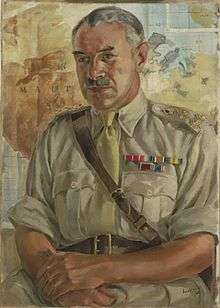Ivan de la Bere
Brigadier Sir Ivan de la Bere KCVO CB CBE (25 April 1893 – 27 December 1970) was a British Army officer in World War I and in World War II when he played a prominent part in the Siege of Malta. Later he was an official in the Royal Household.
Sir Ivan de la Bere | |
|---|---|
 de la Bere, by Leslie Cole, 1943 | |
| Born | 25 April 1893 Cheltenham |
| Died | 27 December 1970 (aged 77) |
| Allegiance | |
| Service/ | |
| Years of service | 1913–1945 |
| Rank | Brigadier |
| Commands held | 1st Battalion Dorsetshire Regiment 233rd Brigade |
| Battles/wars | World War I (France and Belgium) World War II (Malta) |
| Other work | Secretary-General, Central Chancery of the Orders of Knighthood Extra Gentleman Usher to the Queen |
Early life
Ivan de la Bere was born on 25 April 1893, the son of John de la Bere of Battledown Manor, Cheltenham, Gloucestershire. He was educated at Wellington College, Berkshire, and Sidney Sussex College, Cambridge, where he was awarded a Bachelor of Arts degree.[1][2]
Military career
In 1913 de la Bere joined the Regular Army and was commissioned as a Second lieutenant into the Dorsetshire Regiment. During World War I he served two spells of duty in France and Belgium in 1914–15 and 1915–16, including a period attached to the Connaught Rangers, and was wounded. In 1916 he was seconded in the rank of Captain to the Royal Flying Corps.[2][3] In January 1918 de la Bere received a special staff appointment as a Conducting Officer in France, escorting visitors to the armies, and became an Assistant Press Officer in May 1918, retaining that appointment in the British Army of the Rhine after the Armistice with Germany.[3]
De la Bere then spent a number of years in staff positions in the War Office, receiving promotion to Major in 1931.[3] In 1935 he returned to regimental duty in command of the Dorsets' regimental depot. Then in 1939 he was promoted to Lieutenant colonel and took command of the 1st Battalion Dorsets. On the outbreak of World War II they were stationed in Malta.[2]
The Siege of Malta began on 11 June 1940 following Italy's entry into the war. The island was dependent on supply convoys fighting their way through from Gibraltar or Alexandria, and meanwhile, the garrison and people were subjected to some of the heaviest bombing of the war for a period of over two years. For its part, the island provided a base for air and sea attacks on supply convoys to the Italian and German forces fighting in North Africa. On 27 July 1941 de la Bere, by now a Colonel (promoted 27 July 1940), was placed in command of a new Central Infantry Brigade, formed by a brigade headquarters that had come out from the United Kingdom and by infantry battalions that had been brought in as reinforcements from Egypt. De la Bere was injured in November 1941, but returned to duty within three weeks, and commanded the brigade until the end of the war, ending as an Acting Major-General. Central Brigade was redesignated 3rd (Malta) Infantry Brigade in 1942 and later became 233rd Infantry Brigade. During the siege de la Bere organised gifts and activities to maintain the morale of the civil population.[2][4]
Later career
De la Bere retired from the army with the rank of Brigadier after World War II and in 1948 was appointed Secretary-General of the Central Chancery of the Orders of Knighthood, an office within the Royal Household at St James's Palace responsible for administering a large part of the British Honours system. He was the author of The Queen's Orders of Chivalry (1961). He retired in 1960 and the following year was appointed an Extra Gentleman Usher to the Queen, a post that he held until his death.[1][2]
Family
In 1923 de la Bere married Marjorie Minton, daughter of N. A. Minton Haines. They had a daughter who predeceased him. De la Bere died on 27 December 1970.[1][2]
Awards
During his life de la Bere received the following British and Foreign honours and awards:[1]
- Officer of the Order of the British Empire (OBE) 1934, advanced to Commander of the Order of the British Empire (CBE) in 1944.
- Commander of the Royal Victorian Order (CVO) 1950, advanced to Knight Commander of the Royal Victorian Order (KCVO) in 1959.
- Companion of the Order of the Bath (CB) 1957.
- Commander of the Order of St John
- Commander of the Order of Merit of the Federal Republic of Germany
- Commander of the Order of Merit of the Italian Republic
- Commander of the Order of the White Elephant (Thailand)
- Officer of the Legion of Honour (France)
- Officer of the Order of Orange-Nassau (Netherlands)
- Officer of the Order of Radifan (Iraq)
- Officer of the Order of the Dannebrog (Denmark)
- Officer of the Order of the Polar Star (Sweden)
- Personal Order of the Shah of Persia
Notes
- Who Was Who 1961–1970
- Obituary, Times 29 December 1970.
- Gradation list, Annual Army List 1914–39.
- Joslen.
References
- Annual Army List.
- Lt-Col H.F. Joslen, Orders of Battle, United Kingdom and Colonial Formations and Units in the Second World War, 1939–1945, London: HM Stationery Office, 1960/Uckfield: Naval & Military, 2003, ISBN 1 84342474 6.
- The Times.
- Who Was Who.